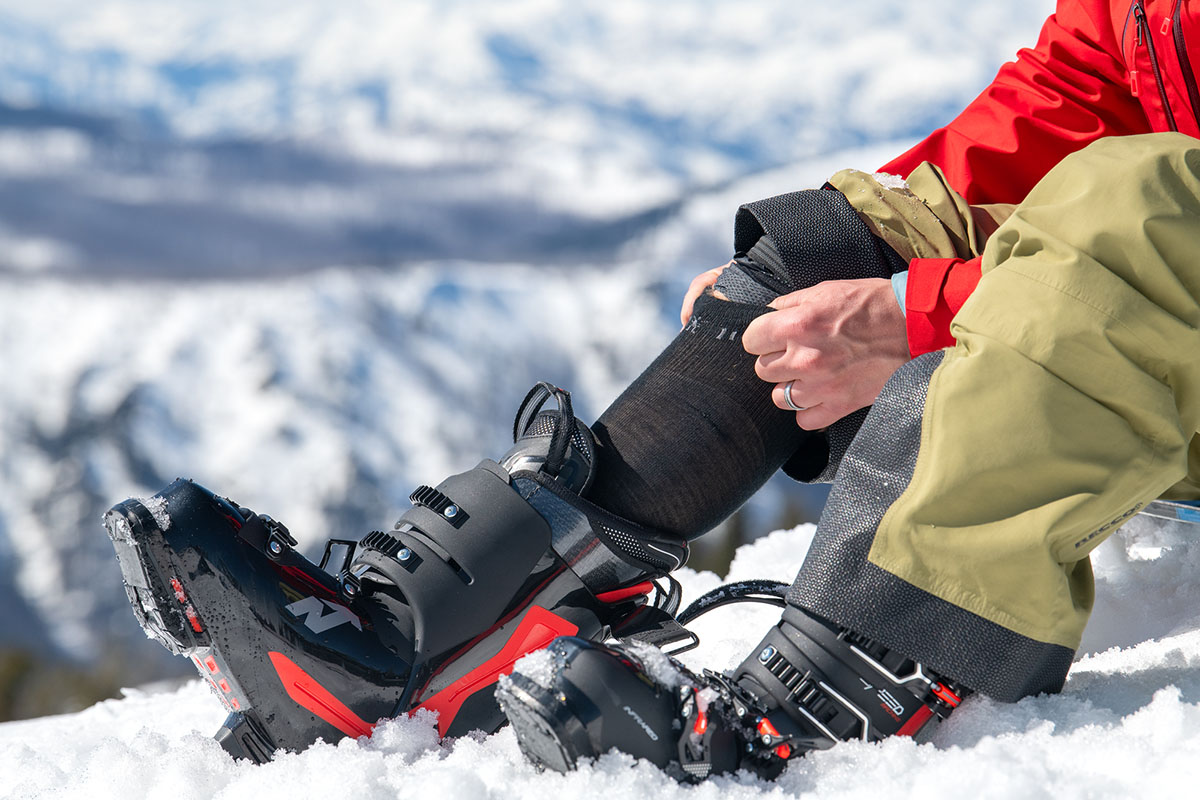
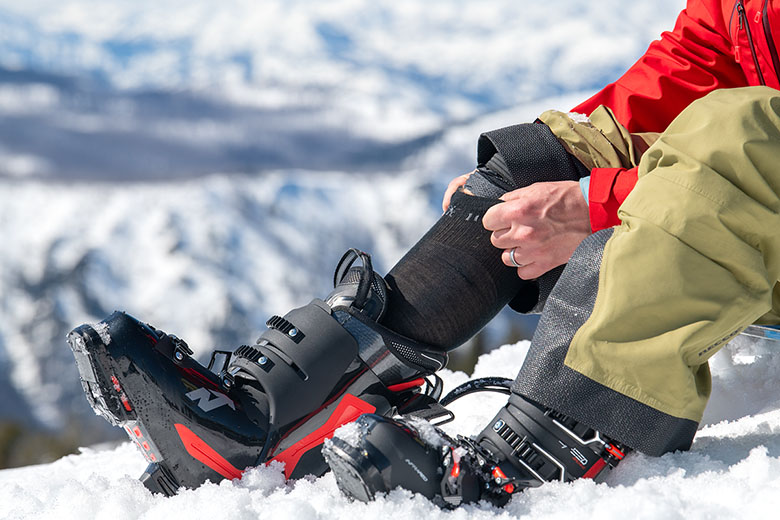
Switchback Travel


Switchback Travel
A quality ski sock gets the basics right: a close but not restricting fit, soft-touch materials that don’t itch, and enough cushioning to keep you on the slopes all day. Every sock that made our “best of” list below for the 2024 season accomplishes this and more. In terms of construction, the current top dog is merino wool. It’s not scratchy like wool socks of old—in fact, it’s quite soft, warm, and comfortable—and repels odor extremely well. You can expect to spend around $30 for merino down to $15 to $20 for a basic wool/stretch nylon blend, with dedicated compression models coming in at around $50 to $60. For more background information, see our ski sock comparison table and buying advice below the picks.
Editor’s note: We updated this guide on October 28, 2024, to add the Stance Medium Performance Wool Snow OTC and swap several designs to the latest versions. We also included information about our testing practices below the picks and swept the guide to ensure all information was current at the time of publishing.
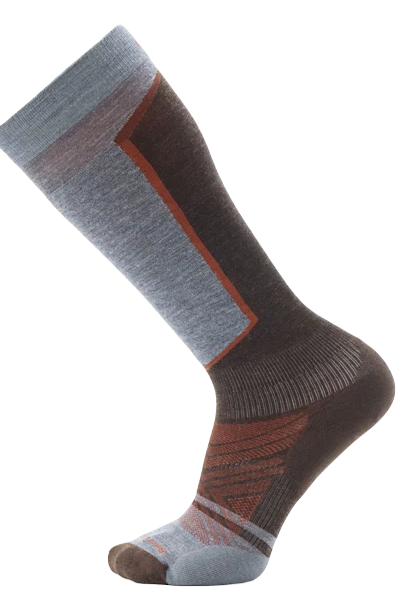 Materials: 57% merino wool, 40% nylon, 3% elastane
Materials: 57% merino wool, 40% nylon, 3% elastane
Thickness: Light/medium
What we like: Great fit and performance with strategic cushioning and mesh for added breathability.
What we don’t: Can’t match Darn Tough’s warranty.
Merino wool specialist Smartwool dominates the ski sock market, and our favorite model for the 2024 season is their Ski Targeted Cushion OTC. Like many Smartwool products, this sock is soft and comfortable, fits and performs extremely well, isn’t prone to loosening (you can wear it multiple times between washes), and looks good to boot (it’s offered in several fun patterns and designs). As the name suggests, the sock also boasts the brand’s targeted cushioning, which concentrates padding in high-wear areas like under the heel and toes with mesh zones for added breathability. The net result: a supportive and intentionally built design that’s great for bombing laps downhill, ski touring, and everything in between.
It’s worth noting that Smartwool falls short of Darn Tough below in both durability and warranty (two years vs. Darn Tough’s lifetime guarantee). However, their Indestructawool technology—a dense wool blend added to high-wear areas like under the heel and toes—has given them a nice boost in longevity. Of note: The model listed here is good for those who run cold, but modern ski boots are meant to fit snugly and have quality liners that do a lot of the insulating work for you. If your boots are already tight or you prefer less cushioning, check out Smartwool’s own Ski Zero Cushion OTC below. On the flip side, Smartwool’s Ski Full Cushion OTC boasts more merino (63%) and is a step up in thickness, coziness, and warmth.
See the Smartwool Ski Targeted Cushion OTC See the Women's Ski Targeted Cushion OTC
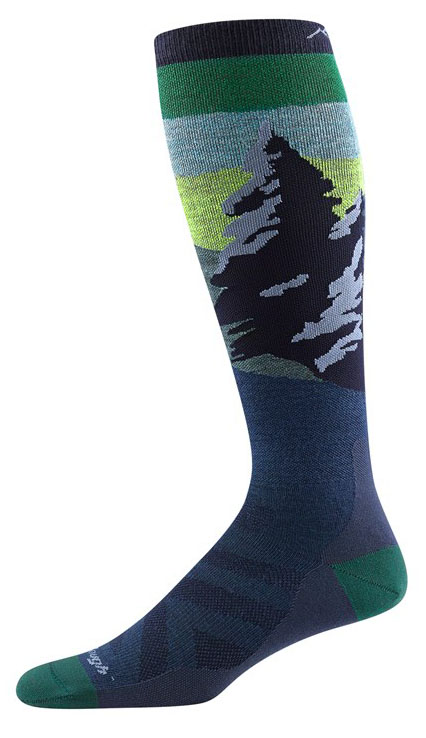 Materials: 52% nylon, 45% merino wool, 3% lycra
Materials: 52% nylon, 45% merino wool, 3% lycra
Thickness: Light
What we like: Quality and durability are hard to match.
What we don’t: Not the softest on the market (but they’re not far off).
In addition to Smartwool, Darn Tough makes some of the best socks on the market: They’re constructed mostly of merino wool, made in Vermont, and come with a lifetime warranty to back them up. But what truly sets Darn Tough apart is the level of durability: We still have ski and hiking models going strong after 5+ years of consistent wear. Their lineup is undeniably extensive—and admittedly a little hard to decipher with all the various names—but we especially like the OTC Lightweight models (including the Solstice and women’s Alpine), which hit a nice middle ground in cushioning and warmth for season-long resort use. There are many variations that differ slightly in price and materials, but all share the same excellent build quality and long-lasting constructions.
The merino/nylon combination of Darn Tough’s OTC Lightweight models is reasonably soft to the touch yet tough, and the seamless design helps to avoid irritation against your foot from a long day on the mountain. Further, the socks have just enough cushioning to offer moderate warmth and protection when leaning hard into your boots. We ranked the Smartwool higher because we prefer its slightly snugger fit and more merino-heavy build, and the Darn Tough socks are a little more prone to loosening if you don’t wash/dry them after every outing. But the quality and durability nevertheless are top-notch, and you really can’t go wrong with either brand.
See the Darn Tough Solstice OTC Lightweight See the Women's Alpine OTC Lightweight
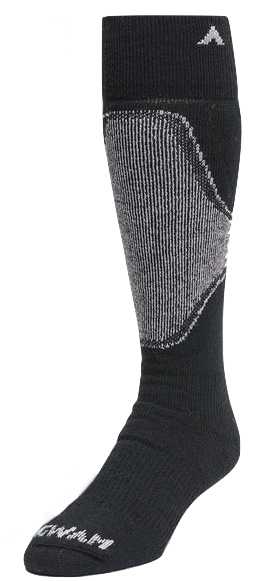 Materials: 60% wool, 30% stretch nylon, 9% stretch polyester, 1% spandex
Materials: 60% wool, 30% stretch nylon, 9% stretch polyester, 1% spandex
Thickness: Medium
What we like: Great cushioning and price.
What we don’t: Bulky and loses its shape over time.
If you’re struggling with the idea of spending $30 or more on a pair of ski socks, the good news is that there are deals out there to be had. Our favorite value option is the Wigwam Sirocco, which is around $10 to $15 less than the Darn Tough and Smartwool options above yet still offers plenty of warmth and comfort for a typical day on the slopes. Keep in mind that the Sirocco is prone to losing its shape over time, but the mix of wool and nylon is cozy and soft, and the medium-thickness cushioning can help fill out a pair of loose-fitting rental boots (although there's no replacement for getting sized right).
It’s important to note that the Wigwam Sirocco is not ideal for performance-oriented skiers, as the sock is a little thick and doesn’t hug your foot as well as the pricier models above. On the plus side, it offers similar levels of warmth (plus more merino than its predecessor), and we’ve found it as cheap as $10 even in the heart of the winter buying season. That’s a downright bargain for weekenders who want a reliable pair of ski socks on a budget.
See the Wigwam Sirocco Midweight OTC
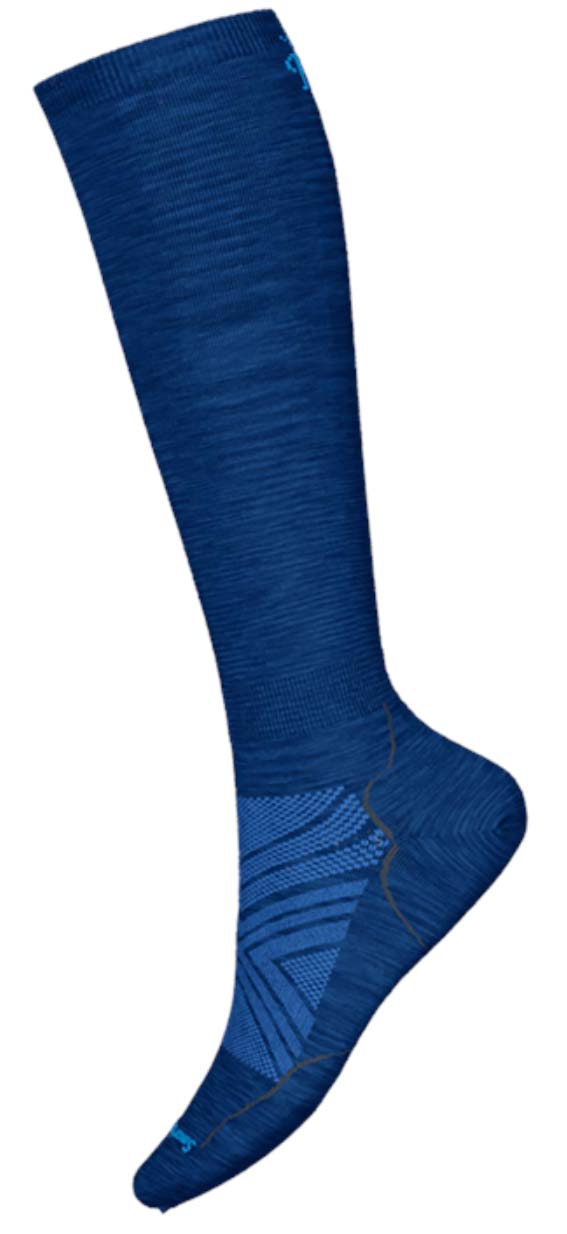 Materials: 55% merino wool, 41% nylon, 4% elastane
Materials: 55% merino wool, 41% nylon, 4% elastane
Thickness: Ultralight
What we like: Close, performance-oriented fit and great breathability for active pursuits like touring.
What we don’t: Durability falls short of the light- and midweight competition.
Ultralight ski socks can be a great option for those with snug-fitting and performance-oriented ski boots—again, your liner does most of the insulating work—and the Smartwool Ski Zero Cushion OTC is our favorite option in this category. The close, minimally padded fit keeps you close to your boots for added precision and feel on the slopes, and you get the same level of comfort and odor-fighting power that Smartwool is known for. We wore the past generation of this sock (the very similarly built PhD Ski Ultra Light) for years, and the latest model shares the same excellent fit and breathability—a great combination for high-output uses like ski touring and exploring the sidecountry.
In choosing an ultralight sock like this one, you do sacrifice some durability. The thicker Smartwool and Darn Tough models above will last much longer, and we don’t recommend wearing the Ski Zero Cushion for anything other than skiing (keeping them on around the house or in town will add unnecessary wear to the thin build). But for backcountry skiers and those who demand a lot of their setup, it’s a well-executed and comfortable performance option at a decent price.
See the Smartwool Ski Zero Cushion OTC See the Women's Ski Zero Cushion OTC
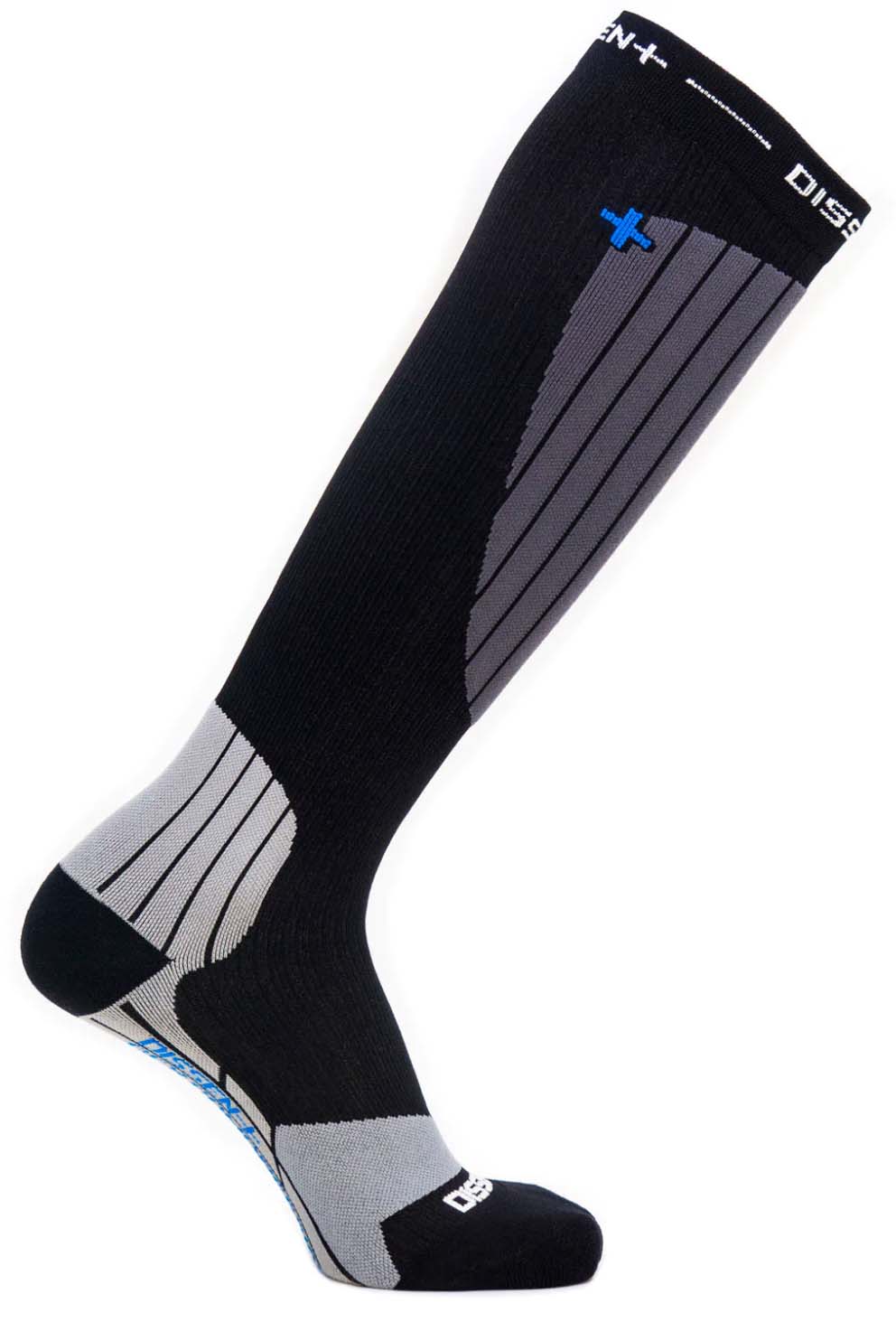 Materials: 64% polyamide, 28% lycra, 8% Nanoglide
Materials: 64% polyamide, 28% lycra, 8% Nanoglide
Thickness: Light
What we like: Excellent compression design for ski touring.
What we don’t: Very expensive.
Dissent Labs may not be on everyone's radar, but they’ve developed a loyal following among the ski touring crowd. What stands out with their GFX Compression Hybrid model is its complete feature set: You get compression for a snug and reliable fit, padding in strategic areas for comfort on the up- and downhill, and a synthetic build that breathes well and dries quickly. All told, it’s a great option for discerning backcountry skiers who have had a tough time finding a well-fitting sock.
The biggest impediment by far with the GFX Compression Hybrid is price. At $58, it’s one of the priciest options on our list—only edged out by CEP’s $60 Ski Ultralight below (also a compression sock). And most resort and backcountry skiers will be just fine with a sock like the Smartwool or Darn Tough options above that come in at around half the Dissent's price. The sheer expense is what hurts it in our rankings, but you can’t fault the GFX’s quality and performance. And for a cheaper but less specialized option, check out Sockwell's Steep Medium Snow, which retails for $30 per pair.
See the Thermic Dissent GFX Compression
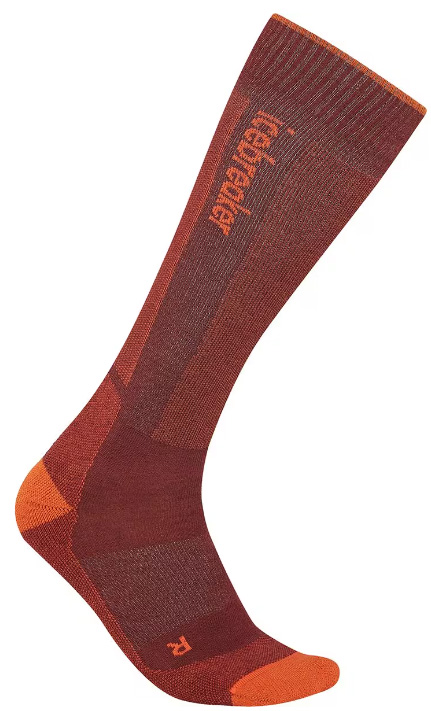 Materials: 52% merino, 47% nylon, 1% elastane
Materials: 52% merino, 47% nylon, 1% elastane
Thickness: Light
What we like: Warm, cozy, and comfortable.
What we don’t: Pills up over time.
New Zealand-based Icebreaker is one of the top manufacturers of merino wool outdoor apparel, and we particularly like their Ski+ Light. Combining a healthy dose of wool with the company’s deft ability to make merino feel silky smooth, and you have perhaps the comfiest ski sock available. The fit also is excellent, and Icebreaker is one of only a few here that makes socks specifically for your left and right foot (although in our experience, the Smartwool socks above fit just as well). Finally, it’s worth noting that the latest version of the sock has less merino (from 70 to 52%) but more nylon than the past generation, which helps with durability and shape retention.
With light padding to protect the bottom of your foot and leg, these socks are warm and wick moisture extremely well. One downside is that they’re prone to pilling up after a few runs through the washer (try and avoid drying them if you can), although the recent boost in nylon should help. Given the similarity in price between these socks and the Darn Tough and Smartwool socks above, it’s a very close call, and you can’t go wrong with any of these brands.
See the Men's Icebreaker Merino Ski+ Light See the Women's Icebreaker Ski+ Light
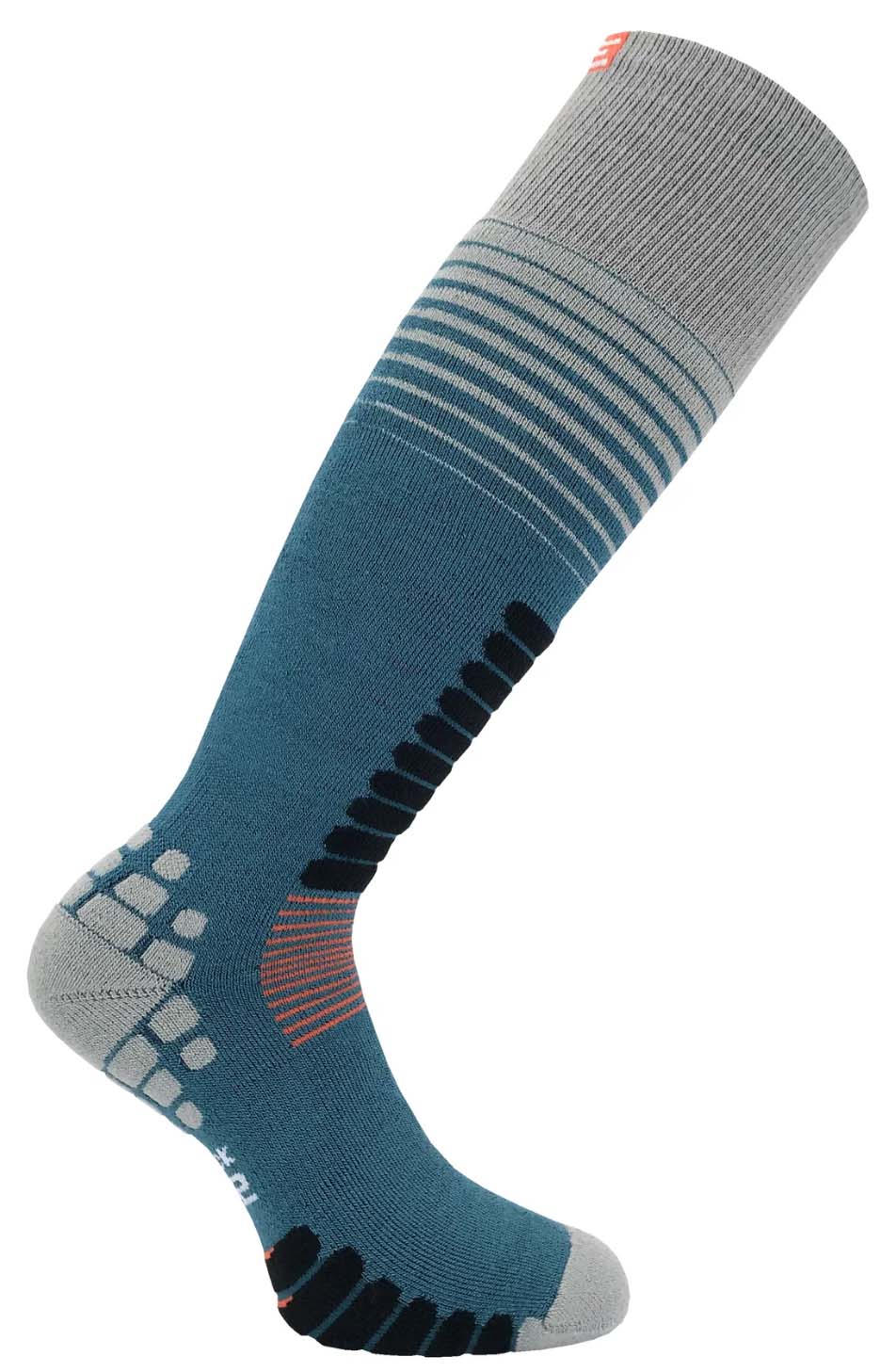 Materials: 80% MicroSupreme, 15% nylon, 5% elastane
Materials: 80% MicroSupreme, 15% nylon, 5% elastane
Thickness: Medium
What we like: A well-made synthetic sock at a great price.
What we don’t: Slightly less comfortable than merino designs.
One of only a few synthetic models on our list, the Eurosock Ski Zone Medium Weight offers a performance fit at a great value. Made up primarily of MicroSupreme, these socks are designed to combat the biggest complaint of synthetic socks: stink retention. While a merino wool sock usually can last a couple days before needing a wash, most synthetics smell rather ripe by lunch. The Eurosocks do an admirable job in this department, falling just a little short of merino. And importantly, the rest of the design is nicely sorted, including extra padding in high-wear areas and a snug, secure fit around the entire foot—plus a nice selection of bright colorways to choose from.
At $24, the Eurosock Ski Zone undercuts much of the competition in price while still delivering fit and performance that stack up decently well to the options above. That said, while the synthetic build does a decent impression of merino’s odor-fighting abilities, these socks will still require washing more frequently than wool alternatives. Comfort is another concession, although the difference isn’t too major. Editor's note: The Medium Weight model here is great for those who prefer the extra volume and warmth, but if you require less cushioning and shin padding, we recommend Eurosock’s Ski Supreme (lightweight) or Ski Superlite (ultralight).
See the Eurosock Ski Zone Medium Weight
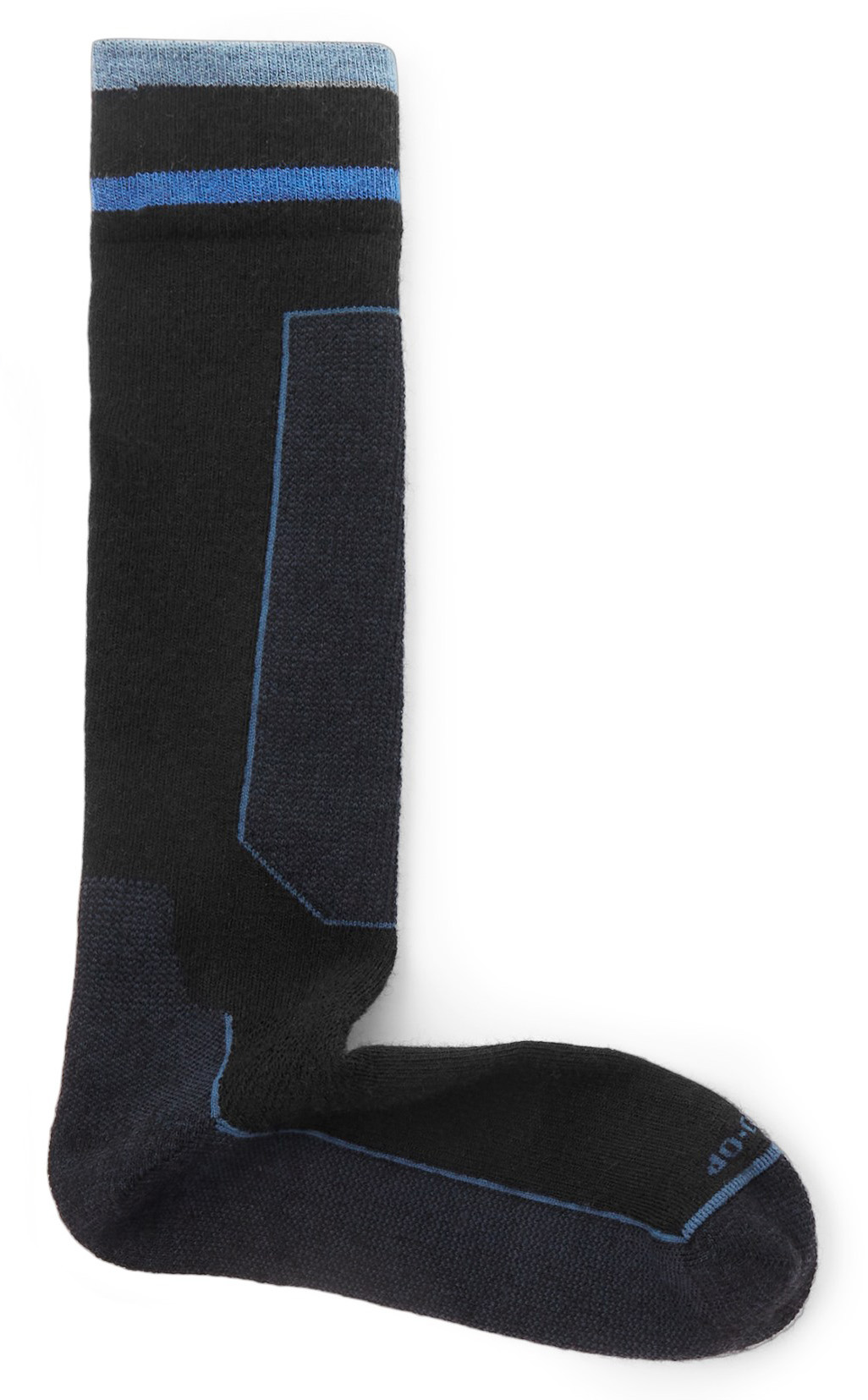 Materials: 49% nylon, 48% merino wool, 3% spandex
Materials: 49% nylon, 48% merino wool, 3% spandex
Thickness: Medium
What we like: Another good value option from our favorite co-op.
What we don’t: Those who get out frequently will benefit from spending up for Smartwool or Darn Tough.
We often turn to REI’s in-house collection when value is a top priority, and their Powderbound Midweight Snow Socks are no exception. Part of the brand’s wider Powderbound lineup—which also includes resort-focused ski jackets, pants, and bibs—these socks will save you $3 to $5 per pair compared to leading options from Smartwool and Darn Tough while stacking up favorably in many areas. Like our top-ranked picks, the Powderbound boasts a healthy dose of merino (48%) to maximize moisture wicking and odor prevention, along with nylon and a little spandex for added durability and stretch. REI also equipped the socks with seamless toes to limit chafing and hot spots, and we appreciate that the fit is snug but not restrictive—plus, the Powderbound holds its shape well over time, which isn’t always the case with REI socks.
What’s not to like with the REI Co-op Powderbound Midweight? For starters, these socks are designed for both skiing and snowboarding, which means you forgo the targeted cushioning around the shin that many of the ski-specific models above offer. They’re also on the thicker side—on par with the Eurosock Ski Medium Weight above and Norrøna Lofoten Mid Merino below—which is great for riders who run cold but overkill for mild conditions (as we covered above, modern ski boots can provide a surprising amount of warmth if fitted properly). If you like the value of the Powderbound Midweight but prefer something thinner, REI also offers the socks in a lightweight version for $1 less per pair. Both options are nice for beginners and casual resort-goers who don’t demand a lot of performance out of their socks, but we’d point dedicated skiers to one of the pricier and more specialized options above.
See the REI Powderbound Midweight
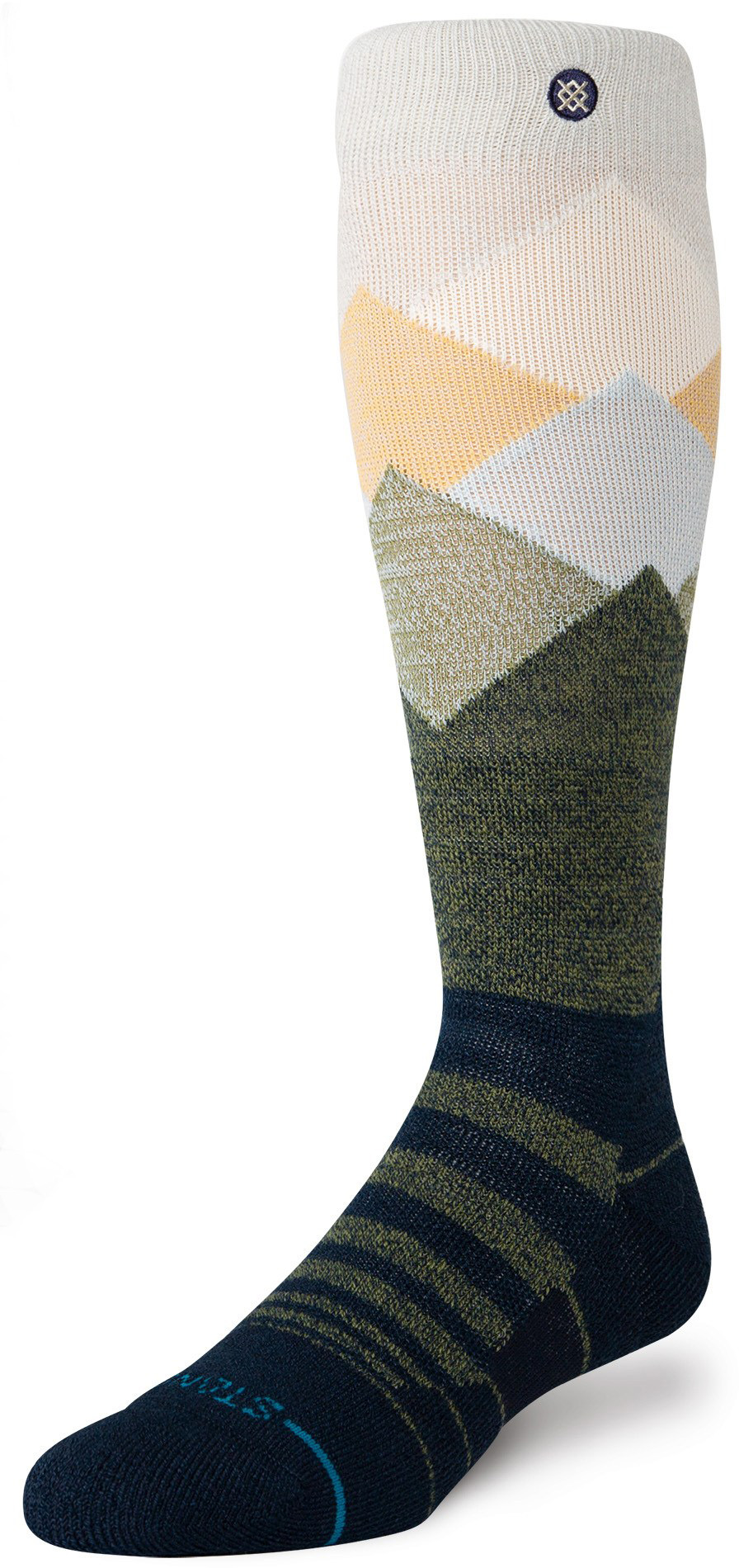 Materials: 46% nylon, 26% polyester, 25% merino wool, 3% elastane
Materials: 46% nylon, 26% polyester, 25% merino wool, 3% elastane
Thickness: Medium
What we like: Fun array of designs and patterns adds a nice dose of flair.
What we don’t: You can get more wool for less.
Stance may lack the name recognition of big-time players like Smartwool and Darn Tough, but make no mistake: This California-based brand knows how to make a solid pair of socks. We’ve tested several of their hiking and skiing designs over the years and have had largely positive experiences with overall quality, durability, and performance. Their Medium Performance Wool Snow OTC socks here are no exception, combining a functional merino blend with the brand’s medium cushioning, mesh zones for added breathability, built-in arch support, and a seamless toe closure to prevent rubbing. And we can’t help but love the vibrant selection of fun patterns, which pumps some serious flair into the market.
It's important to note that each sock under the Medium Performance Wool Snow OTC moniker uses a different mix of materials, with the merino content ranging from 20% to 31% depending on colorway. The “Misty” pattern shown and linked here contains 25% merino wool, which is considerably less than what you get with our top-ranked Smartwool (57%) and Darn Tough (45%) picks. Those socks will cost you an additional $3 and $1 per pair, respectively, making them the better overall value. But the Stance stacks up well in overall performance, and we think the fun and good-looking designs help bridge the price gap.
See the Stance Medium Performance Wool OTC
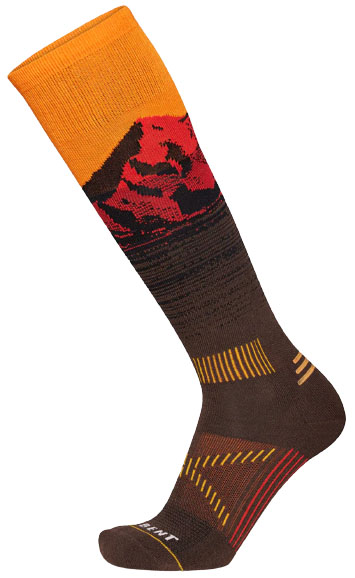 Materials: 44% bamboo rayon, 35% nylon, 19% merino wool, 2% elastane
Materials: 44% bamboo rayon, 35% nylon, 19% merino wool, 2% elastane
Thickness: Light
What we like: Purpose-built for long days on the skin track.
What we don’t: Expensive and overkill for most.
Designed in collaboration with decorated freeskier Cody Townsend, the namesake Cody Townsend Pro Socks from Lé Bent are tailor-made for committed backcountry riders. One unique addition is the use of rayon from bamboo, which is soft and smooth against the skin and provides a nice boost in all-day comfort. The socks also include silicone strips along the back of the ankle and around the cuff to minimize bunching, which is especially helpful while ascending steep slopes, when your foot is prone to moving around inside your boot. Rounding out the build, you get added cushioning at the toe box for extra warmth and impact resistance, a compression-like fit at the shin and calf, and mesh ventilation zones over the top of the foot to release excess heat. Taken together, the Cody Townsend Pro is about as purpose-built as it gets for heart-pumping backcountry riding.
All that said, $38 is a steep investment for a pair of socks, and not everyone needs (or will want to pay for) this level of performance. For reference, you can save $8 to $10 by opting for the Smartwool Ski Targeted Cushion OTC or Darn Tough OTC Lightweight above, both of which include more merino for better odor resistance and moisture management. That said, we’ve found the Cody Townsend Pro to be a quality competitor to those designs with excellent comfort, shape retention, and stretch. And for an even more breathable option, Lé Bent offers the socks in a Zero Cushion model for an additional $2 per pair.
See the Lé Bent Cody Townsend Pro
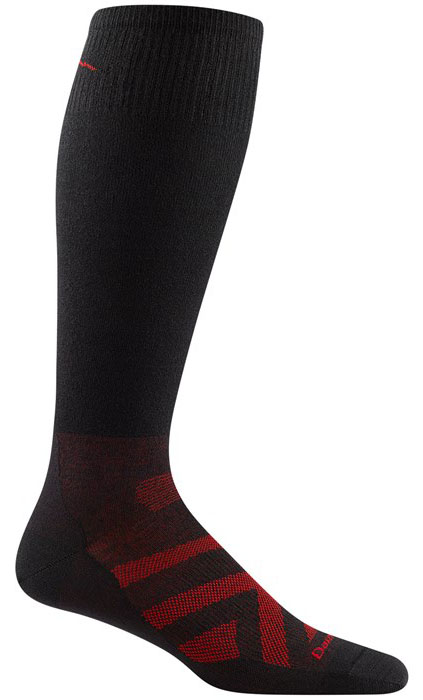 Materials: 52% nylon, 43% polyester, 5% spandex
Materials: 52% nylon, 43% polyester, 5% spandex
Thickness: Ultralight
What we like: More durable than merino.
What we don’t: Still nearly as expensive.
As we noted with the Eurosock Ski Zone Medium Weight above, many of the socks on the list are made with merino wool, and most of the time it’s the main actor. In this case, however, the Darn Tough Thermolite RFL is made with nylon and polyester for a low-profile, breathable, and lightweight ski sock. If your boots run small (we’re thinking of you, ski racers) or you just want minimal loft in your socks for high-output activities like sidecountry hikes or touring, the Thermolite RFL offers Darn Tough quality in an all-synthetic package.
Again, there are a few downsides to bypassing merino. Synthetics build up stink more quickly, so you’ll want to wash these socks after every day on the slopes. Second, they don’t offer quite the same next-to-skin softness as merino, although Thermolite still is reasonably comfortable. Finally, you don’t get much in the way of cost savings here. With baselayers, for example, going with a synthetic can save you as much as 50% over merino, which makes them very attractive. Here, you’re only saving a couple bucks, but synthetics do tend to last much longer, which adds value in the long run. All in all, we like the Thermolite RFL—which also comes in a thicker version called the Thermolite Edge—but we still give the nod to merino, especially when comparing offerings at a similar price point.
See the Darn Tough Thermolite RFL See the Women's Darn Tough Thermolite RFL
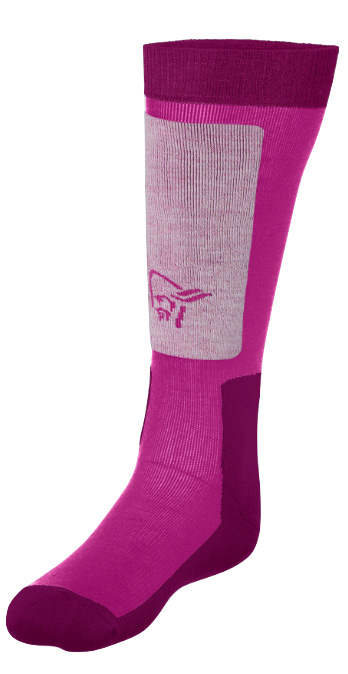 Materials: 51% merino wool, 45% nylon, 4% elastane
Materials: 51% merino wool, 45% nylon, 4% elastane
Thickness: Medium
What we like: Purpose-built for cold backcountry missions.
What we don’t: Considerably pricier than comparable designs from Smartwool and Darn Tough.
For those unfamiliar, Norrøna is a mountain brand that specializes in premium, highly protective shells for harsh alpine environments. In line with that focus, their Lofoten Mid Merino Socks are a high-performance design for freeriders who aren’t turned off by the cold. Like many options here, the Lofoten uses a mix of merino, nylon, and a little elastane for an effective balance of comfort, moisture management, odor resistance, and durability. Other highlights include a snug, compression-like fit; great breathability for working up a sweat in cool to cold conditions; and excellent comfort for all-day outings. Finally, we appreciate Norrøna’s transparency about their production practices—these socks are made with traceable wool to ensure the fair treatment of sheep, and Norrøna provides a comprehensive factory list on their website with details on worker wages, how each plant is powered (fossil fuels or renewable energy), and much more.
As its name suggests, the Lofoten Mid Merino is a midweight design with more cushioning than lightweight options like the top-ranked Smartwool Targeted Cushion OTC and many others above. This is great for midwinter resort days and frigid tours, but if you run warm or don’t have enough room in your boots to accommodate the added bulk, we’d recommend Norrøna’s Lyngen Light Merino Socks. Compared to the Lofoten, the Lyngen contains less merino (43%) but will save you $10 per pair. Both designs are significantly more expensive than comparable options from Smartwool or Darn Tough, but we’ve been thoroughly impressed by the quality of Norrøna’s products as a whole. If you can justify spending up, you won’t be disappointed.
See the Norrøna Lofoten Mid Merino
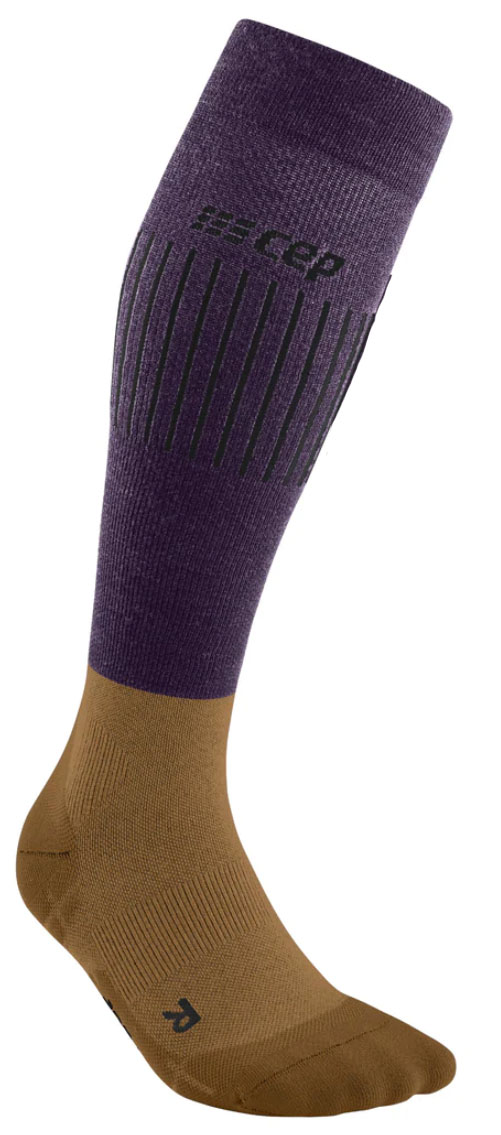 Materials: 64% polyamide, 22% merino, 14% spandex
Materials: 64% polyamide, 22% merino, 14% spandex
Thickness: Ultralight
What we like: A high-performance option from a company built around compression.
What we don’t: Only for those with finicky cold feet; take some extra effort to get on and off.
CEP is a compression-focused company that makes socks for activities like running, hiking, cycling, and more. From their ski lineup, we think the Ski Ultralight is a winner. Made with a quality mix of nylon, merino wool, and spandex, these socks are for those who suffer from cold feet or want to get a leg up on muscle recovery. The high price tag is due to the graduated compression technology that gently squeezes muscles in the lower leg to promote blood flow for warmth and recovery. While not everyone will like the snugness, it nevertheless adds a boost in support for those who need it.
With comparatively little merino in the build, the CEP Ski Ultralight isn’t as soft as the wool-intensive builds above, plus you don’t the same level of odor-fighting ability. And as is the case with most compression models, the CEP is around double the cost of our top picks. In the end, here’s our take: If you’re struggling with cold feet or just really prefer the secure fit, the CEP Ski Ultralight is a nice option and one of the most performance-focused designs on our list. Otherwise, we think it’s worth saving with one of the merino-heavier socks above. Of note: CEP also offers a more breathable Ski Touring model for the same price, although it has even less wool (18%).
See the Men's CEP Ski Ultralight See the Women's CEP Ski Ultralight
| Sock | Price | Materials | Thickness | Padding |
|---|---|---|---|---|
| Smartwool Targeted Cushion OTC | $30 | 57% merino, 40% nylon, 3% elastane | Light/medium | Yes |
| Darn Tough OTC Lightweight | $28 | 52% nylon, 45% merino, 3% lycra | Light | No |
| Wigwam Sirocco Midweight OTC | $17 | 60% wool, 30% nylon, 9% polyester, 1% spandex | Medium | Yes |
| Smartwool Ski Zero Cushion OTC | $29 | 55% merino, 41% nylon, 4% elastane | Ultralight | No |
| Thermic Dissent GFX Compression | $58 | 64% polyamide, 28% lycra, 8% Nanoglide | Light | Yes |
| Icebreaker Merino Ski+ Light OTC | $29 | 52% merino, 47% nylon, 1% elastane | Light | Yes |
| Eurosock Ski Zone Medium Weight | $24 | 80% MicroSupreme, 15% nylon, 5% elastane | Medium | Yes |
| REI Co-op Powderbound Midweight | $25 | 49% nylon, 48% merino, 3% spandex | Medium | No |
| Stance Medium Performance Snow | $27 | 46% nylon, 26% polyester, 25% merino, 3% elastane | Medium | No |
| Lé Bent Cody Townsend Pro | $44 | 44% rayon, 35% nylon, 19% merino, 2% elastane | Light | Yes |
| Darn Tough Thermolite RFL UL | $27 | 52% nylon, 43% polyester, 5% spandex | Ultralight | No |
| Norrøna Lofoten Mid Merino | $49 | 51% merino, 45% nylon, 4% elastane | Medium | Yes |
| CEP Ski Ultralight | $60 | 64% polyamide, 22% merino, 14% spandex | Ultralight | Yes |
One key to a great day at the resort or in the backcountry is happy feet, and a quality pair of ski socks can go a long way. Former editor-in-chief and lifelong skier John Ellings put together our initial list of eight socks in 2015, drawing from years of experience on the slopes throughout the Pacific Northwest. Managing editor Sarah Nelson began contributing to the guide in 2020 and now manages the round-up, ensuring each pick that makes the list has met a rigorous set of performance requirements. Currently based in the Lake Tahoe area, Sarah has ridden all over the Mountain West but logs most of her ski days at Palisades Tahoe.
Our current selection of 13 ski socks is the result of ongoing testing, firsthand info from trusted contributors, and feedback from the online skiing community. Comfort is at the top of our priority list when we test socks, and we also look closely at warmth, cushioning, and overall fit. We make note of how quickly each pair grows smelly between washes, hoof it into the sidecountry or backcountry to get a gauge on breathability, and document any durability issues (e.g., tears and pilling) over the long-term. As always, we continue to test new and noteworthy socks as they become available to keep up with the ever-changing market.
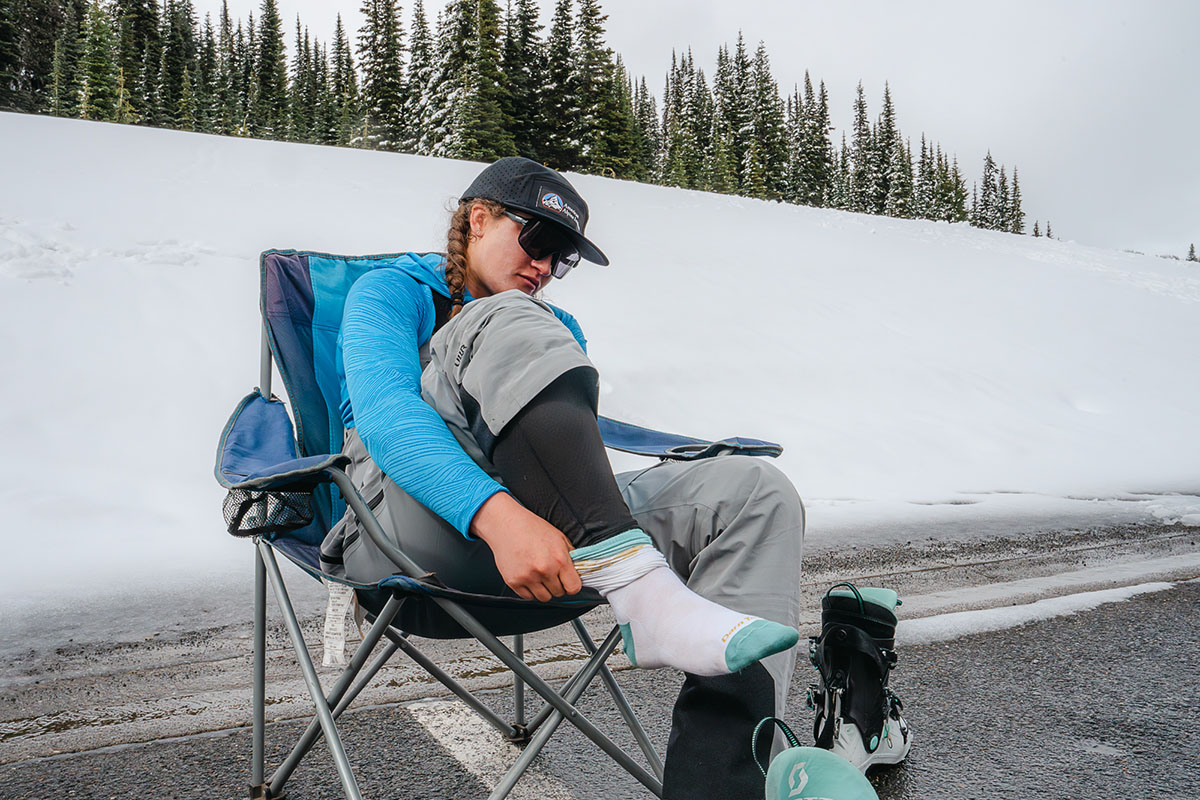
Merino Wool
Despite a higher cost, merino remains the most popular and our most recommended ski sock material for a number of reasons: excellent fabric feel that’s soft and comfortable, odor resistance, and superior temperature regulation. In other words, merino socks are able to keep your feet warm when the mercury drops, but you should also remain cool when spring rolls around. All told, it’s the full meal deal for your sock needs (we cover this information in greater detail in our article: Merino Wool: Is It Worth It?).
Granted, merino wool socks are rarely pure merino. A blend of fabrics, usually including some nylon for toughness and elastane or spandex for stretch, is required to provide a supportive fit that stays in place. Additionally, the fabric weave and construction is an important consideration, because some brands like Darn Tough prioritize long-term durability over supreme softness with a dense weave, while others like Icebreaker sacrifice a little on lifespan for coziness.
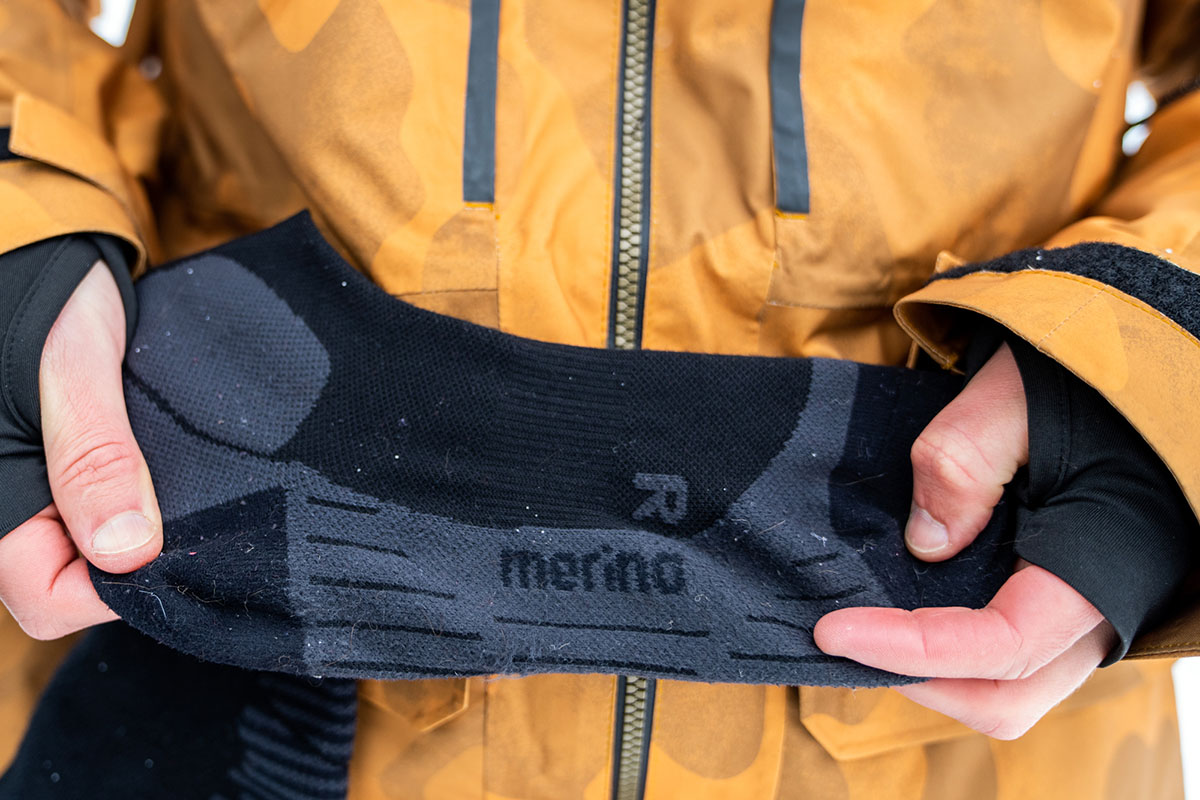
Synthetic
Most of our top picks are made with merino. However, not everyone is totally smitten with the higher price tags. For a more cost-effective alternative, you can turn to a synthetic option. The designs will vary depending on brand, but some common features in synthetic socks are a performance fit and superior moisture-wicking properties. Keep in mind you’re not going to experience amazing breathability inside a ski boot—the hard shell of the boot prevents that—but these synthetic socks do manage to pull sweat away from your feet as efficiently as possible. The downsides are warmth and stink prevention, although some brands have worked very hard to combat the latter complaint. MicroSupreme in the Eurosock Ski Zone Medium Weight is an example of a synthetic that does a decent job at keeping the smells to a minimum.
Nylon
Merino and synthetic are the two most common materials used in sock construction, while nylon is a secondary fabric that boosts durability and gives the socks a consistent shape. Ski socks are designed to fit snugly and not bunch up or slide around (we cover this more in our “Fit and Sizing” section below), and this is where nylon and spandex come into place. The elastane or spandex lets the fabric flex, while nylon gives the sock a structure that retains its shape even after being stretched and supports your foot, ankle, and lower leg. We list the fabric construction for each product on this list and you’ll notice a theme: 15-50% nylon. More nylon is usually associated with a performance fit that should retain its shape and avoid sagging over time.
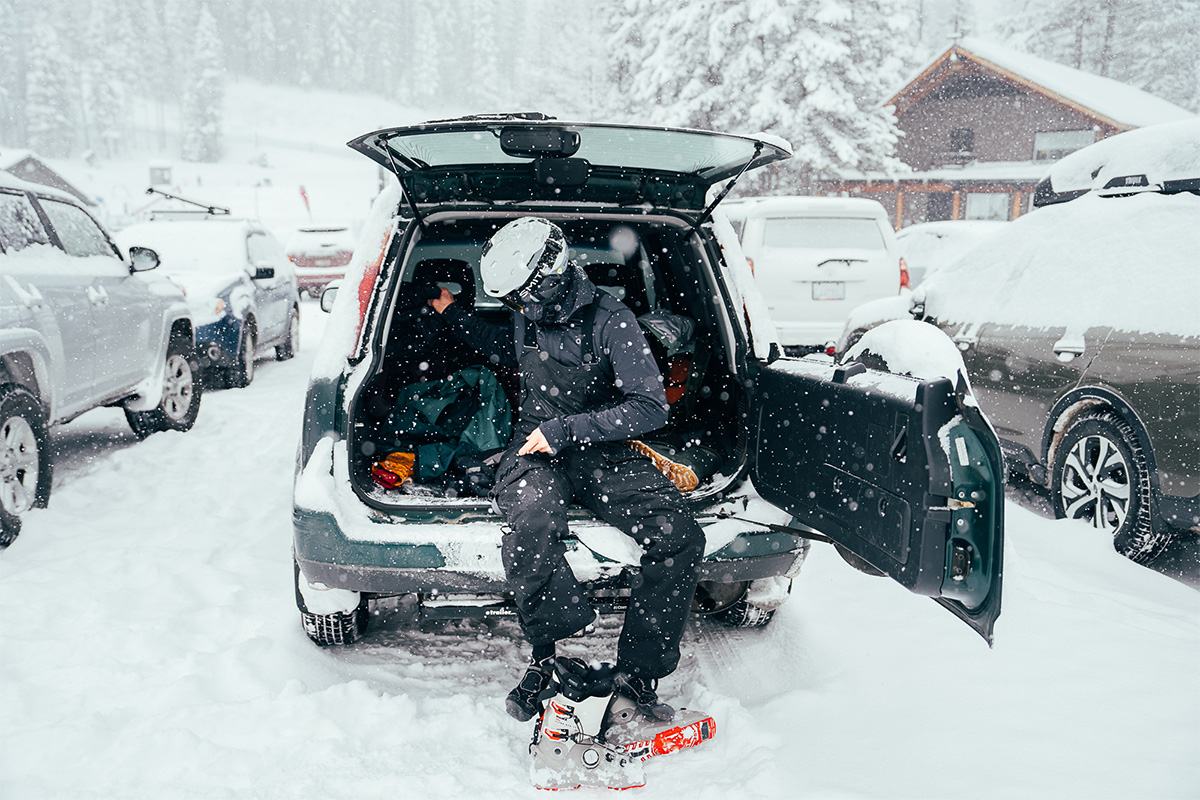
Ultralight
Amazingly, a super-thin ultralight sock can be a suitable option even in cold conditions—as long as you’ve spent big bucks on a nice pair of modern ski boots. Boot liners insulated with products like microfiber Thinsulate are able to trap hot air against your feet far better than ever before. As long as your liner fits you well and you don’t go out in positively frigid conditions, an ultralight sock is perfectly suitable. The closer, streamlined fit also improves contact with the boots for improved performance.
Regarding durability, ultralight socks fall short of the other options simply by the thickness of their design. We wouldn’t suggest wearing them too much out of the boots. These ultralight options, including the Smartwool Ski Zero Cushion OTC, are most popular with those who work hard—hiking or ski touring. Those who require a little extra cushioning or warmth may want to look at the more all-around friendly lightweight category below.
Lightweight
For standard downhill skiers, the lightweight category is a great place to be—with enough cushioning around and under your foot to be comfortable but not so thick and bulky that it feels awkward inside your boot. Those who like to run an ultralight sock for average conditions or for ski touring may want to have a slightly thicker, lightweight option for those chilly days. Some of our favorite options include Darn Tough’s OTC Lightweight models and the Icebreaker Merino Ski+ Light OTC.
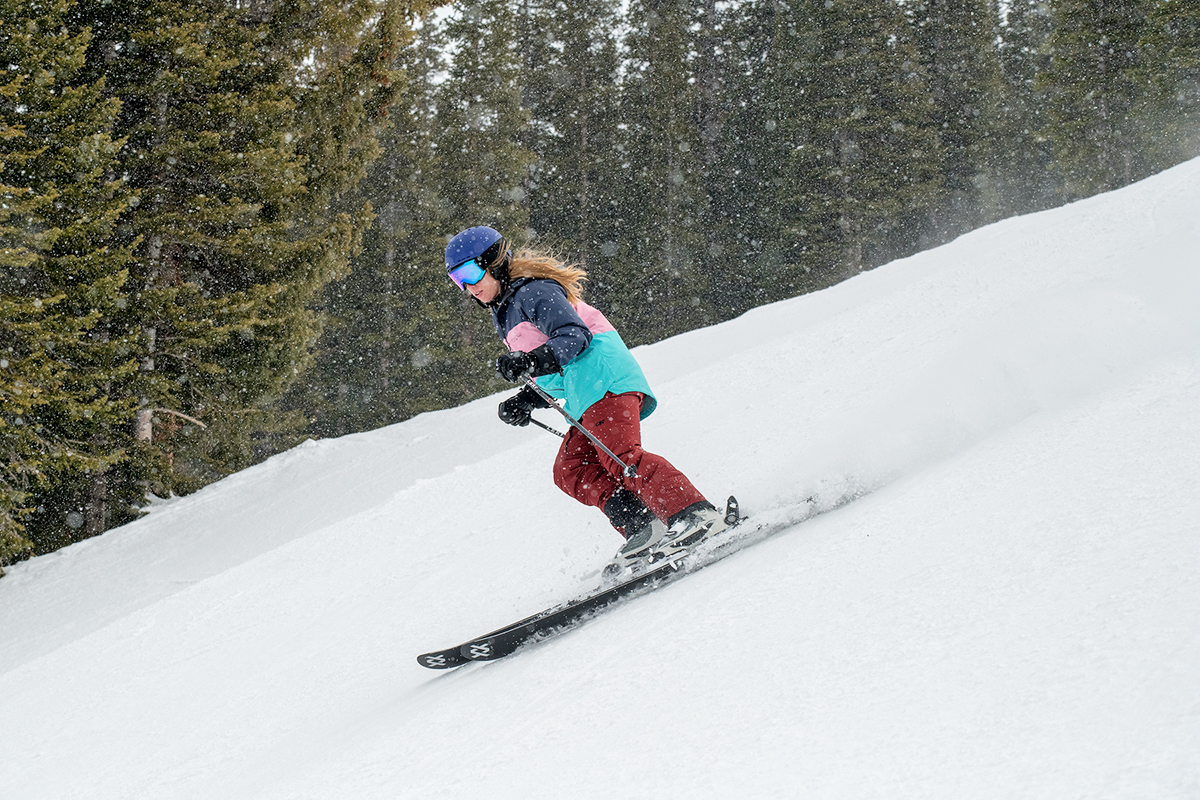
Midweight
Ski socks of old used to fall into this category, but the changes in ski boot technology have made a thicker sock far less important. The benefit of a midweight sock, such as REI Co-op’s Powderbound Midweight, is added cushioning inside a boot, and for those who run cold no matter what, it may be worth having a midweight option. But keep in mind, boot liners are meant to fit snug, so a sock that is too thick can actually restrict blood flow and make your feet even colder. Be sure to dial in your fit just right if you plan to run a thicker, midweight sock. If your boots are too big or you’ve packed out your liners, it could be a viable option.
We usually recommend choosing a ski sock with some degree of padding along the shin for all-day comfort and to take the sting out of shin-bang (or when landing a jump). It’s something that is enjoyed by casual and performance skiers in both the resort and backcountry, and is especially helpful for skiing on hardpack when your stance is more forward (as opposed to powder, when you’re more upright). Most often, ski-specific socks with more cushioning underfoot also include a healthy amount of shin protection. There are, however, a few ultralight padded options out there that combine a non-cushioned design with some shin protection. And a final point here: Be wary when eyeing crossover ski and snowboarding socks, as these models typically forgo the targeted cushioning around the shin (we cover more of the differences in our section on Ski Socks vs. Snowboard Socks below).
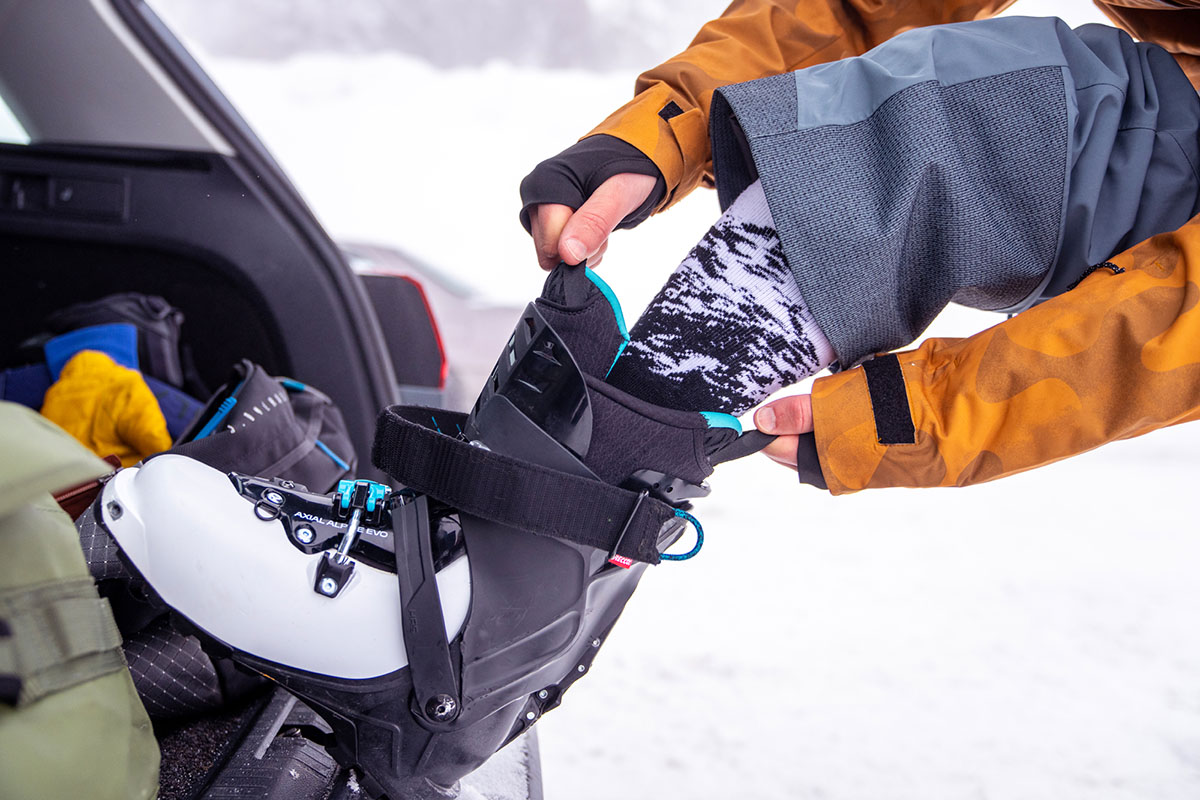
Ski socks have a few simple tasks: keep you warm, fit well and stay in place, and wick moisture. A sock’s wicking ability is particularly important for backcountry skiers or those prone to working up a sweat. If the sock gets wet and stays wet, your feet can become cold pretty quickly. This is where merino wool shines—not only does it wick moisture well, but it continues to insulate even when wet (unlike cotton). And while synthetic materials dry quickly, they can’t retain as much of the moisture as merino and working up a sweat will make them smell bad. The thickness of the material also plays a role, and thinner merino wool socks, like the Icebreaker Merino Ski+ Light, are standouts in this category.
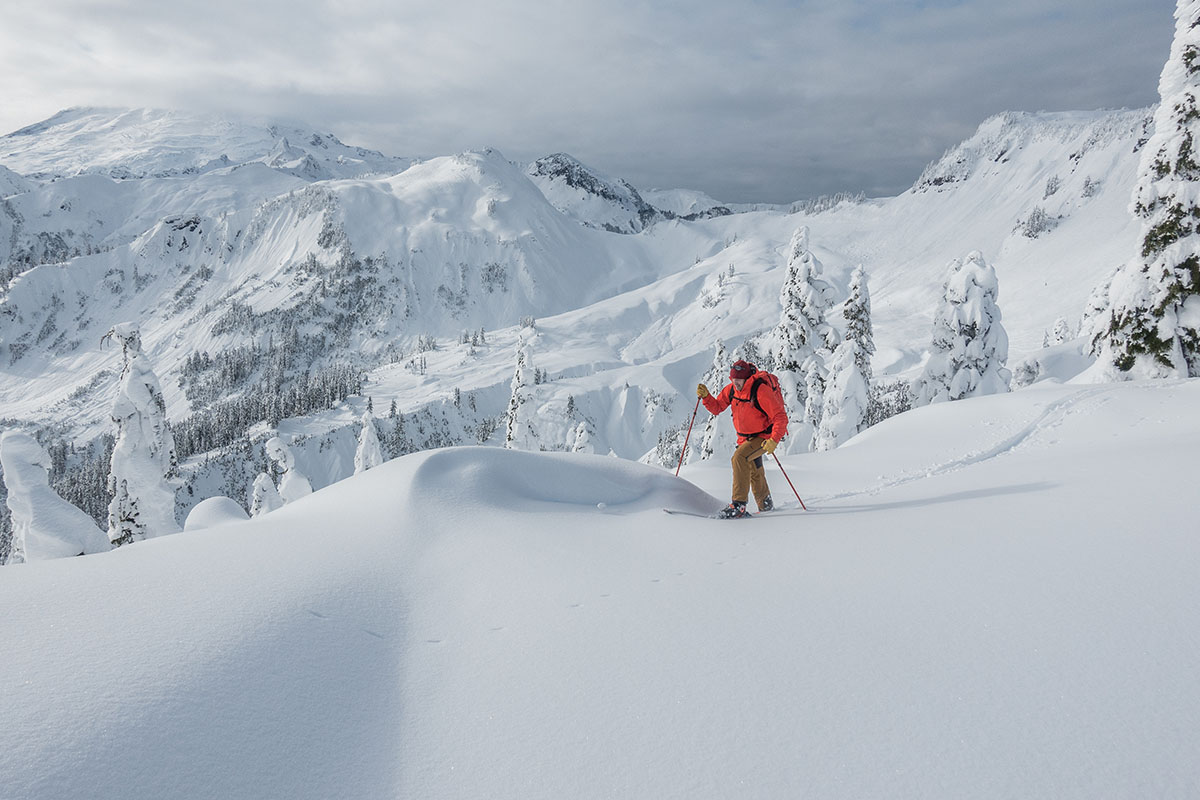
Following trends in running and performance gear, ski socks brands have been offering up more and more compression options. The goal of a compression sock is improved blood flow. In a ski sock application, the goal is to leverage this improved blood flow to boost warmth as well as possibly reducing muscle fatigue. While it’s a difficult thing to prove, in our experiences with compression socks, we’ve found them to have a very close fit that just may offer a slight increase in warmth. What we can say definitively is compression socks do offer a very supportive fit with zero bunching that performance skiers should enjoy.
A compression sock fits exactly as you’d expect: very tightly. Enough so that it can require a bit of strategy to slide them on and off. Another downside of designs like the Thermic Dissent GFX Hybrid and CEP Ski Ultralight is a substantial bump in price, which can be nearly double the cost of a comparable standard ski sock (those socks retail for $58 and $60, respectively). The average skier absolutely does not need a compression sock, and only those looking for a very tight and secure fit—and perhaps a slight improvement in recovery time and warmth—should consider spending that much for a pair of socks.
More so than nearly any other application, having a proper fitting sock for skiing is essential. Make sure your socks feel tight around your toes, ankle, and shin without being restrictive. Any excess material and bunching can spell trouble when pinched in between your foot or leg and boot liner. This can create hot spots or worse, blisters. You also shouldn’t have to peel the socks off (compression options are the exception). Look to the sock fit range for sizes, and if you’re right on the fence, we recommend sizing down.
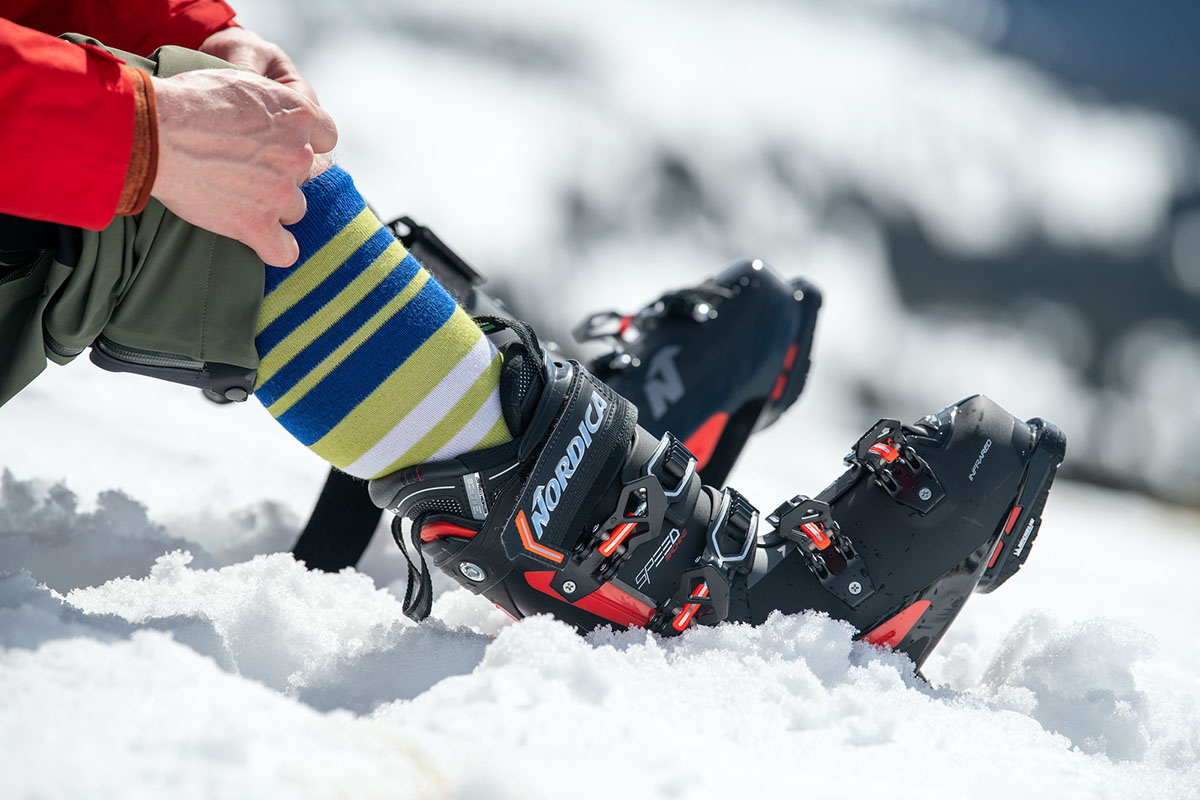
When looking at the list above, you might notice that all of the socks fall just below the knee. This is to account for the height of ski boots, which typically rise to the mid or high shin. Any sock that falls below the top of your boot can create serious discomfort and rubbing against the skin, so it’s important to have a little wiggle room. The main takeaway: it’s best to choose a ski-specific model (as opposed to a hiking sock or other type of sock) to ensure you’re getting enough coverage.
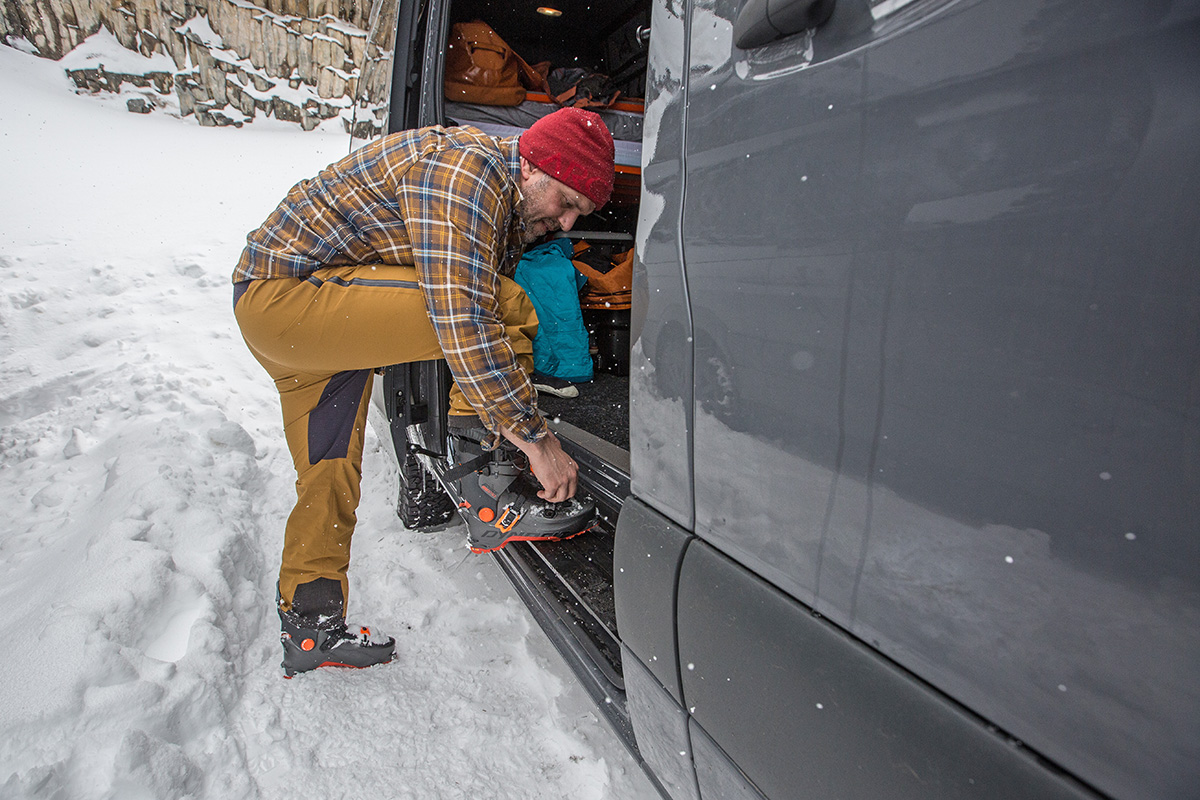
Many ski socks are sold as unisex, but some on our list offer women’s-specific versions. These models are often a bit shorter—for example, the Smartwool Ski Zero Cushion OTC men's sock is 14 inches, while the women's version is only 13. Why? Women’s legs, on average, are a bit shorter than men’s, and the difference is meant to provide a better, more tailored fit. All that said, we consider pretty much any sock gender-neutral—go with what feels best.
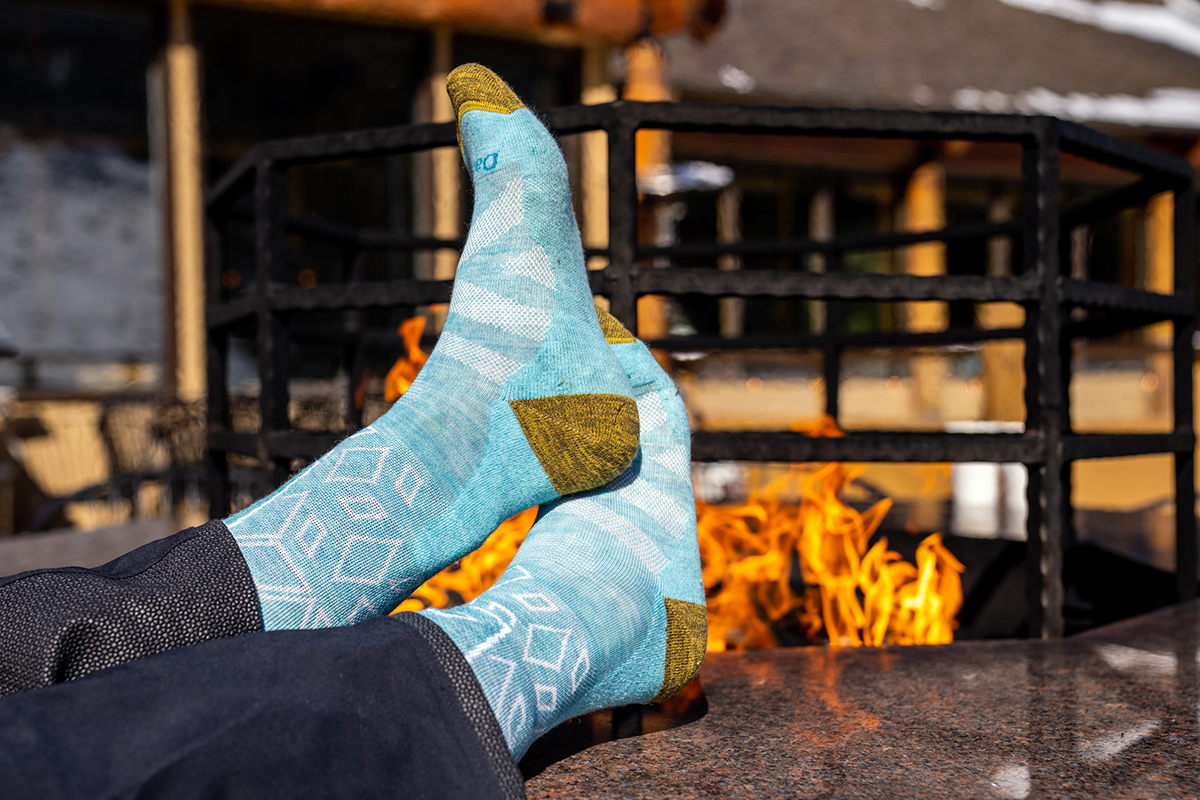
The outdoor industry has made notable inroads in the sustainability realm over the past several years, and the ski sock market is no exception. One common practice is the use of recycled fabrics, as seen in Smartwool’s Ski Targeted Cushion OTC (30% recycled nylon) and Ski Zero Cushion OTC (31% recycled nylon). You may also come across socks that are certified to the Responsible Wool Standard (RWS)—a designation that indicates that the wool has been sourced humanely without unnecessary harm to the sheep and the land they graze on is being managed responsibly. The RWS label is more common among wool baselayers, but we hope to see it continue trickling down into the ski sock market.
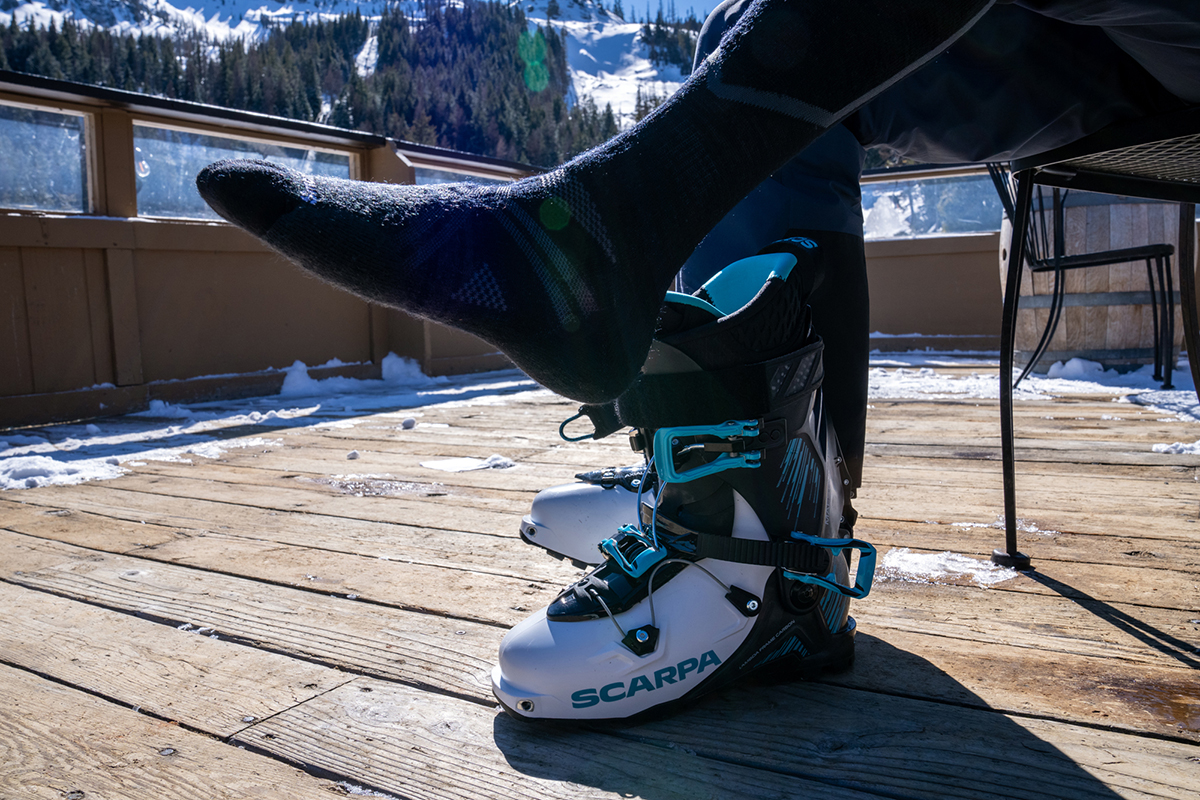
The socks above are purpose-built for skiing, but there are a healthy number of options on the market for snowboarders as well. Due to differences in boot fit (snowboarding boots typically are much looser than ski boots), most snowboarding socks fall toward the thicker end of the spectrum, with midweight varieties dominating the landscape. Further, socks designed for snowboarding focus much of the padding at the top of the foot rather than the shin, which helps maintain comfort while strapped tightly into bindings. Given these important distinctions, we advise choosing a sock that aligns with your specific objectives. Smartwool’s Performance line includes several snowboard-friendly options with varying levels of cushioning. Burton’s Performance Midweight Snowboard Socks are another popular pick and come with premium touches like an odor-resistant footbed and Dryride toe panel for added breathability at the front of the foot.
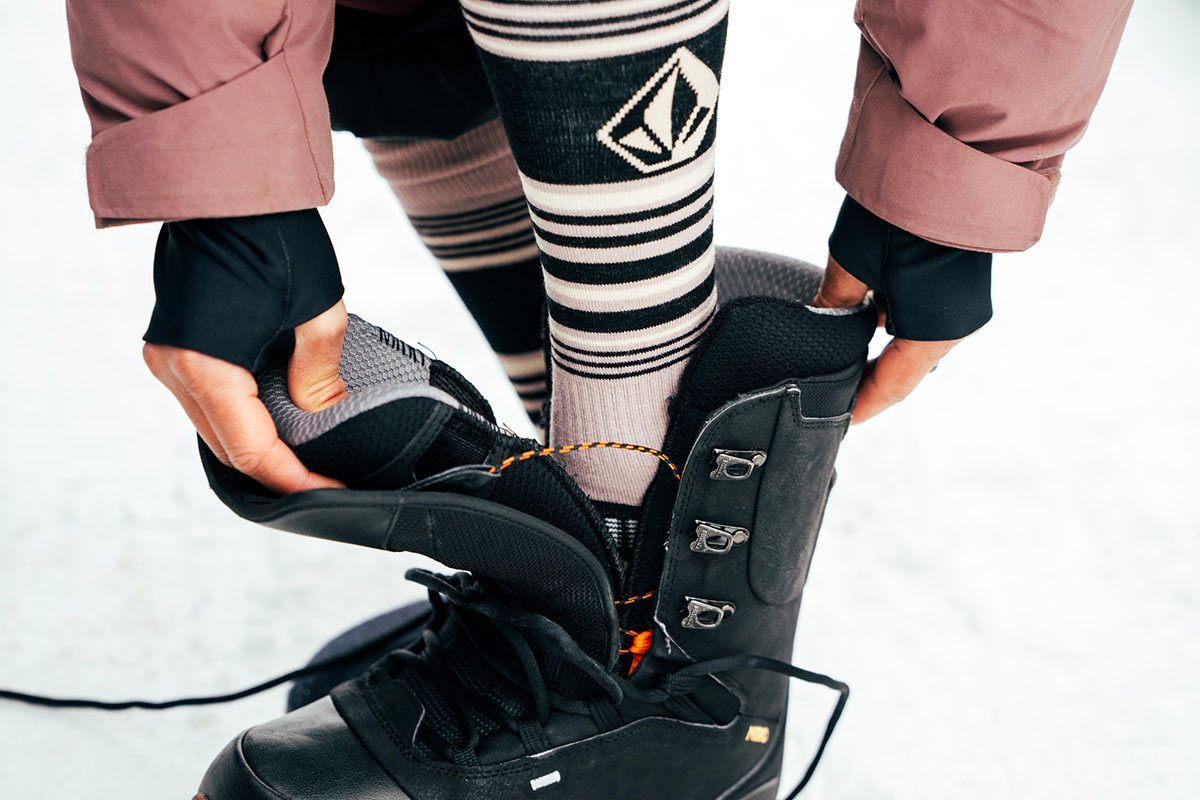
All of the picks above are downhill-oriented ski socks, but cross-country skiers have a slightly different set of requirements. In terms of construction, most dedicated cross-country models have a lower cut that falls about mid-calf, added cushioning around the foot, and no padding in the shin due to differences in boot design and foot movement. We also find that these socks cross over nicely for other winter activities like snowshoeing and ice skating. While regular ski or hiking socks will work just fine, XC models are much more purpose-built and will help maximize comfort and performance. A couple of our favorite designs are Darn Tough’s Oslo and Smartwool's Nordic Targeted Cushion.
As we mentioned above, getting the proper sock fit is a key part of the warmth equation—a well-fitting sock should fit snugly to maximize heat-trapping abilities. But if you’ve exhausted your options and still find yourself getting cold feet on the slopes, heated socks could be a viable solution. Hotronic and Lenz are consistent leaders in this realm, and their offerings range from minimally padded options to compression socks for reducing fatigue. Importantly, the heating elements are sold separately, but the process is simple: Snap one of the brand’s battery packs into the inner cuff, turn the device on, and choose your heat setting. Hotronic also sells kits that include compatible heated insoles as well for additional warmth underfoot. The biggest downside is cost: The kit will run you around $200-$300. Alternatively, budget shoppers can also consider disposable toe warmers—Ignik sells packs for as low as $7 for four.
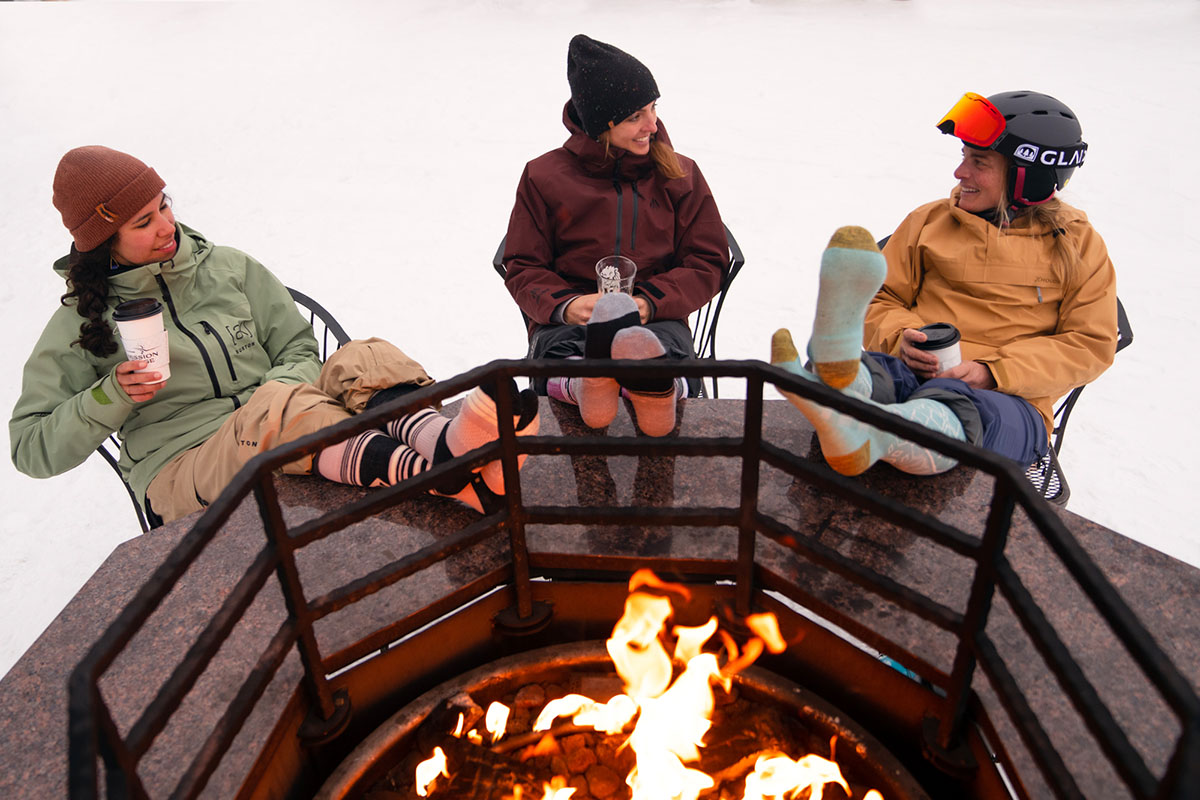
The advanced construction and materials used for ski socks do not lend themselves to being particularly durable. The nylon and merino wool blends are focused on a low profile fit that sits well in your boot, and are prone to developing holes over time. As such, we recommend taking good care of your expensive ski socks. And, if you’ll be skiing a lot, it may be worth investing in a more expensive pair that comes with a warranty. Darn Tough stands out here with their amazing lifetime guarantee, and Icebreaker also comes with a 100% satisfaction guarantee (with no time restriction).
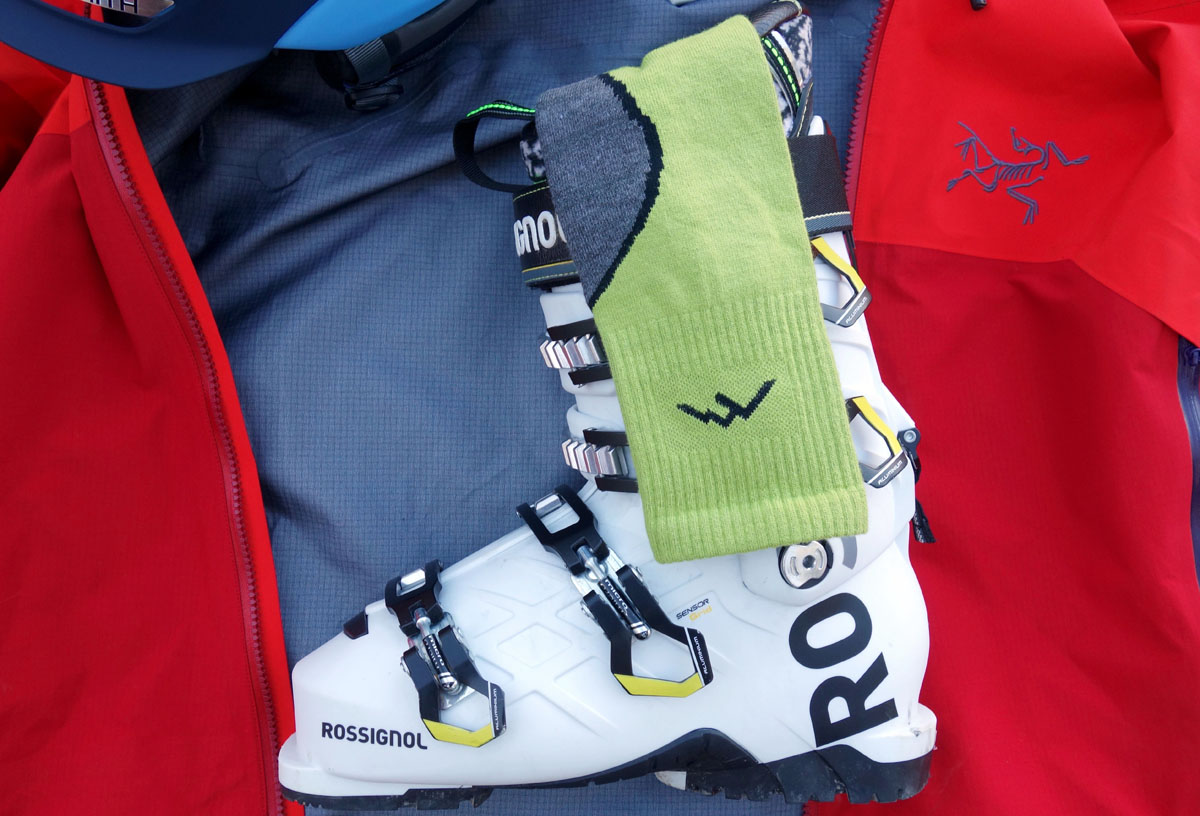
For sock care, it’s always best to follow the instructions given by the manufacturer. What we’ve found to be most successful is to turn them inside out and wash in cool or warm water—and use tech wash occasionally to help get out any lingering smells. To avoid pilling and premature wear, we always suggest avoiding the drier and line drying them instead.
Back to Our Top Ski Sock Picks Back to Our Ski Sock Comparison Table